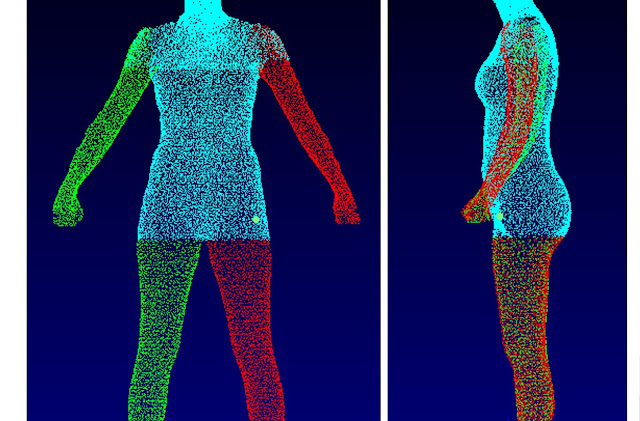Whole-body scanning: What are the impacts on body image?
Clothing specialists at Manchester Metropolitan University and University of Manchester have worked with a number of retailers, body scanning men and women in an attempt to improve industry sizing systems. They have found that although ethical procedures were strictly upheld during measurement procurement, a very small number of women were distressed when shown their 3D body models. Another observation was that, in general, men appeared to be less concerned about having to undress to their underwear during the scanning process and were less sensitive about seeing images of their bodies than were women.
Access to body scan images in public spaces such as supermarkets and other retailers is largely unregulated, which raises the important question of how people respond to seeing their bodies in three dimensions on a computer screen, and how access to these kinds of images affects body image, particularly in a context where many women and men are dissatisfied with some aspects of their appearance (Grogan, 2017; Murray, 2016). We have been interested in this issue for the last five years and have run a number of studies to investigate women’s and men’s accounts of whole-body scanning and how it affects how they see their bodies.
What is whole-body scanning?
Whole-body scanning normally involves people undressing to their underwear,
and being scanned in a small cubicle or curtained area. The person is then able to view a detailed 3D screen image on
the computer screen, and may also be shown a 2D printed version of the image
along with a list of body measurements. Scan images show people their bodies
from all angles. Although some scanners
enable people to view photo-realistic images, body scan images normally look
something like the image below which is known as a “point cloud”, so skin
colour/smoothness and other surface factors are not visible. These kinds of 3D
images give people unique views of their bodies as the image can be rotated on
the computer screen so that people can see their bodies from all possible
angles.
How do people react to being whole-body scanned?
We have now run a number of studies to
investigate women’s reactions to whole-body scanning. Our team comprises
psychologists (Sarah Grogan, Jenny Cole, Maryam Ahmed, Daisy O’Brien, Sarah
Kilgariff, Amanda Whalley, Sofia Persson, Emma Storey, and Christopher J.
Armitage) and also those engaged in clothing technology (Kathryn Brownbridge,
Simeon Gill, Jayne Gill, and Clair Templeton), based at Manchester Metropolitan
University and University of Manchester.
This inter-disciplinary team enables us to focus on psychological and
clothing-related aspects of body scanning in women and men.
In our first study in this area, we ran interviews with twenty 18-40 year old UK women after they had been whole-body scanned (Grogan, Gill, Brownbridge, Kilgariff & Whalley, 2013). Women said that they had found the images informative in providing a realistic and objective view of their body, and were generally quite positive about how their bodies looked on the scans. These results suggested that women may feel more positive about their bodies following scanning. However, we were aware that this was a self-selected group of women who were all relatively young (18-45 years), and all within a narrow range of dress sizes (UK 10-14).
For our second study we contacted a larger and more varied group of women who had been body-scanned at a fashion event. Respondents were ninety-one women aged 18-81 years old who were asked to tell us about their experiences of scanning, retrospectively and anonymously on an open-ended online questionnaire (Grogan, Gill, Brownbridge, Warnock & Armitage, 2016). Responses were much more negative than in the 2013 study. Respondents reported feeling threatened and vulnerable when seeing their bodies on the printed output and reported increased body dissatisfaction as a result of viewing their scans.
In our most recent study with women, fourteen women were interviewed before and after scanning (Grogan, Siddique, Gill, Brownbridge, Storey, & Armitage, 2017). This group were similar in both age (22-45 vs.18-45), and Body Mass Index (18-29 vs 19-28) to those in the original 2013 study. Twelve women expressed “surprise” and “shock” at how they looked in the scan (which was sometimes slimmer and sometimes heavier than expected), and focused on negative elements of the scan, even when asked to talk about positives. All women were comfortable with the scanner process, and found being scanned quicker and easier than expected, but thought that other women, if vulnerable, would find viewing the scan challenging.
Although men tend to report lower levels of body dissatisfaction than women, many men are dissatisfied with their appearance (Franko et al., 2015), so we need to know more about how scanning might affect men’s body image. In a bid to understand men’s experiences of scanning, we recently interviewed ten men aged 18-39 years, before and after scanning (Grogan, O’Brien, Brownbridge, Gill, Cole, and Armitage, 2019). Seven men reported looking shorter, fatter, thinner, and/or less symmetrical on the scan than they had hoped, though three were pleasantly surprised by the images. Men were interested in scans, both as an objective view of their bodies and as to motivate healthy eating and exercise, suggesting that whole-body scanning may encourage men to exercise and eat more healthily. For instance, one man said “It serves as a very good wakeup call”. However, seven men had become more negative about their bodies as a result of seeing their body scans, suggesting that scanning needs to be carried out with supervision and support for men as well as for women.
In our first study in this area, we ran interviews with twenty 18-40 year old UK women after they had been whole-body scanned (Grogan, Gill, Brownbridge, Kilgariff & Whalley, 2013). Women said that they had found the images informative in providing a realistic and objective view of their body, and were generally quite positive about how their bodies looked on the scans. These results suggested that women may feel more positive about their bodies following scanning. However, we were aware that this was a self-selected group of women who were all relatively young (18-45 years), and all within a narrow range of dress sizes (UK 10-14).
For our second study we contacted a larger and more varied group of women who had been body-scanned at a fashion event. Respondents were ninety-one women aged 18-81 years old who were asked to tell us about their experiences of scanning, retrospectively and anonymously on an open-ended online questionnaire (Grogan, Gill, Brownbridge, Warnock & Armitage, 2016). Responses were much more negative than in the 2013 study. Respondents reported feeling threatened and vulnerable when seeing their bodies on the printed output and reported increased body dissatisfaction as a result of viewing their scans.
In our most recent study with women, fourteen women were interviewed before and after scanning (Grogan, Siddique, Gill, Brownbridge, Storey, & Armitage, 2017). This group were similar in both age (22-45 vs.18-45), and Body Mass Index (18-29 vs 19-28) to those in the original 2013 study. Twelve women expressed “surprise” and “shock” at how they looked in the scan (which was sometimes slimmer and sometimes heavier than expected), and focused on negative elements of the scan, even when asked to talk about positives. All women were comfortable with the scanner process, and found being scanned quicker and easier than expected, but thought that other women, if vulnerable, would find viewing the scan challenging.
Although men tend to report lower levels of body dissatisfaction than women, many men are dissatisfied with their appearance (Franko et al., 2015), so we need to know more about how scanning might affect men’s body image. In a bid to understand men’s experiences of scanning, we recently interviewed ten men aged 18-39 years, before and after scanning (Grogan, O’Brien, Brownbridge, Gill, Cole, and Armitage, 2019). Seven men reported looking shorter, fatter, thinner, and/or less symmetrical on the scan than they had hoped, though three were pleasantly surprised by the images. Men were interested in scans, both as an objective view of their bodies and as to motivate healthy eating and exercise, suggesting that whole-body scanning may encourage men to exercise and eat more healthily. For instance, one man said “It serves as a very good wakeup call”. However, seven men had become more negative about their bodies as a result of seeing their body scans, suggesting that scanning needs to be carried out with supervision and support for men as well as for women.
Conclusions
At present, it is unclear as to whether
whole-body scanning may be generally beneficial or harmful to body satisfaction,
and some men and women report positive reactions to their scans. However, many
women and men reported negative reactions, and had noticed new parts of their
bodies to critique having seen their bodies on the computer screen. The
increased body concerns reported by some of our interviewees suggest that if
whole-body scanning is used in supermarkets and other public places, it needs
to be administered with careful supervision, to avoid increasing body-related
concerns. Further work is needed to understand how body scanning should be
delivered in these kinds of public contexts to avoid potential harm. This is
particularly urgent given that men and women can currently access whole-body
scans in clothes retailers with no support at all, which could leave some
people less body satisfied as a result of body scanning.
Sarah Grogan is Professor of Psychology Health and
Wellbeing at Manchester Metropolitan University. She is interested in body
image and body scanning, as well as links between body image and health-related
behaviours such as smoking, UV protection, and alcohol consumption.
Kathryn Brownbridge is Senior Lecturer in Fashion design at Manchester Metropolitan University. Her
formative years in fashion were as a designer for her own fashion company in
Manchester, making clothes for clubbers. In 2001, Kathryn completed an MSc,
which led to an interest in how the use of 3D technologies, including whole
body scanning, could be used to improve fashion practice and people’s
perceptions of their clothed and unclothed body.
References
Fan, J., Yu, W. & Hunter, L. (2004). Clothing Appearance and Fit: Science and
Technology. Cambridge: Woodhead Publishing Ltd.
Franko, D. L., Fuller-Tyszkiewicz,
M., Rodgers, R., Holmqvist
Gattario, K., Frisen, A., Diedrichs, P. C., Ricciardelli,
L. A., Yager, Z., Smolak,
L., Thompson-Brenner, H. & Shingleton, R. (2015). Internalization as a mediator of
the relationship between conformity to masculine norms and body image attitudes
and behaviors among young men in Sweden, US, UK, and
Australia. Body Image, 15, 54-60, DOI: 10.1016/j.bodyim.2015.05.002
Griffiths, L. (2014). Artec rolls out Shapify Booth to Asda
stores. http://www.tctmagazine.com/3D-printing-news/artec-rolls-out-shapify-booth-to-asda-stores/ Accessed 24th October 2016.
Grogan, S. (2017). Body image: Understanding body dissatisfaction in men, women and
children (3rd ed).
London: Routledge.
Grogan, S., Gill, S., Brownbridge, K., Kilgariff, S., & Whalley, A.
(2013). Dress fit and body image: A thematic analysis of women's accounts
during and after trying on dresses. Body Image, 10, 380-388. DOI: 10.1016/j.bodyim.2013.03.003
Grogan, S. Gill, S., Brownbridge, K., Warnock, D. & Armitage, C.
(2016). Women’s long-term reactions to whole-body scanning: A mixed methods
approach. Clothing and Textiles Research
Journal. 34 (1), 75-83. DOI: 10.1177/0887302X15603117
Grogan,
S., Siddique, M.A., Gill, S., Brownbridge, K., Storey, E., & Armitage, C,J,
(2017). ‘I think a little bit of a kick is
sometimes what you need’: Women’s accounts of whole-body scanning and likely
impact on health-related behaviours. Psychology
and Health, 32(9), 1037-1054. DOI: 10.1080/08870446.2017.1329933
Grogan. S., O’Brien, D., Brownbridge, K., Gill, S., Cole, J. &
Armitage, C.J. (2019). “I didn’t realise I was such a sausage”: Men’s Accounts
of Whole-body Scanning, Body Image, and Expected Changes in Health-related
Behaviours. Psychology and Health.
DOI: 10.1080/08870446.2018.1549326.
Istook, C,L, (2000). Rapid prototyping in the textile and apparel
industry: A pilot project. Journal of
Textile and Apparel Technology and Management. 1 (1), 1-14. DOI:
10.1.1.125.598
Loker, S., Ashdown, S., & Carnrite, E. (2008). Dress in the third
dimension: Online interactivity and its new horizons. Clothing and Textiles Research Journal. 26, 164-176. DOI:
10.1177/0887302X08315176
Kokoszka, P. (2018). Is 3D Body Scanning the Future of Fashion.
https://www.verdict.co.uk/3d-body-scanning-fashion-future.
Accessed 12th February 2019
McCabe, M.P., Ricciardelli, L.A., Sitaram, G. &
Mikhail, K. (2006). Accuracy of body size estimation: Role of biopsychosocial
variables. Body Image, 3 (2),
163–73. DOI: 10.1016/j.bodyim.2006.01.004
McCrum,
K. (2015). Asda launches 3D printing service - offering customers a chance to
clone themselves as tiny figures. http://www.mirror.co.uk/news/uk-news/asda-launches-3d-printing-service-5778093 Accessed 26th October 2016.
Murray, S. (2016). The 'Fat' Female Body. London: Palgrave.
Rogers, C., Martz, D.M., Webb, R.M., &
Galloway, A. (2017). Everyone else is doing it (I think): The power of
perception in fat talk. Body Image, 20, 116-119.DOI: 10.1016/j.bodyim.2017.01.004




Amazing post! Consult a licensed doctor for more advice on taking care of your skin and hair, click for more PRP Treatment in East Delhi
ReplyDelete